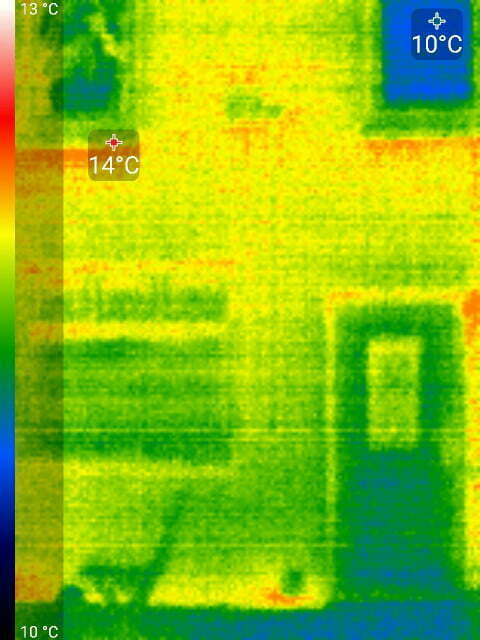Thermal Imaging Our Home
As I blogged about a few weeks ago, I've been playing with the Seek Thermal Compact Infrared Camera. I've been using it for such incredibly interesting things as seeing how cold my nose is and whether my radiators are balanced. Fun!
But what I really wanted it for is to see how well - or poorly - insulated our new house is. So I waited until it was freezing outside, then turned the heating on to max for an hour, then went outside to see whether there were any obvious leaks.
First thing was a long shot of the property - with an LED streetlamp in the foreground.

It's good to see that the camera can pick up the heat of the lamp. I'm not really interested in whether the readings are completely accurate - I just want to make sure that the camera can discriminate relative temperatures. From this perspective, things are looking good! The property's walls are a fairly uniform temperature. There are no prominent hot-spots where the radiators are. The windows, naturally, are slightly warmer. But not massively.
Let's take a closer look at one of the windows:

This is fairly typical of our windows. I was glad that there weren't huge leaks all around the edges. But the tops of each window had a thermal disparity.

So it might be worth replacing the UPVC seals, and re-doing the sealant around the edges.
The back of the house was slightly different:

On the top right is a hot-spot - that's the flue from the boiler. The hot "line" is the drainpipe which acts as the overflow from the boiler, I think. The hot circle is the exhaust hole for an extractor fan. It looks like the wall is very thermally leaky - but I think that's a quirk of the camera. As I panned down, I got this image:

That looks much more like I was expecting. But let's pan down to ground level:
 As expected, there's a bit of escape around the back door - but what's that hot-patch near the ground? Zoom! Enhance?
As expected, there's a bit of escape around the back door - but what's that hot-patch near the ground? Zoom! Enhance?
 That's the vent for the tumble-drier. Not really a huge amount I can do about that. Hot air and moisture need to esape. There's a similar warm patch on the left of the image which is our Rediffusion Junction Box.
That's the vent for the tumble-drier. Not really a huge amount I can do about that. Hot air and moisture need to esape. There's a similar warm patch on the left of the image which is our Rediffusion Junction Box.
Thoughts
This was a quick experiment. The camera - and it is a cheap addon - isn't always great at telling temperature, especially at a distance. For some "quick and dirty" visualisations, it is pretty good. But I suspect I'd get better clarity and more information out of a more expensive model.
I'm hoping that when / if the temperature drops to below freezing, and the heating has been on longer, I'll get a better idea of how our insulation is working. I'm also toying with the idea of taking thermal images of the houses around me. Although I'm not sure of the legal / ethical implications of publishing them!
I can remember some winters when ‘poor mans thermal imaging’ let you see who had lagged their loft, by seeing which houses kept snow on their roof and which ones were clear! Happily nowadays less snow and less badly insulated loft spaces around.
| Reply to original comment on twitter.com
I’d love to do this! (Not sure I’d love it enough to justify spending a couple hundred quid on a thermal imaging camera, but it’s very cool all the same)
| Reply to original comment on twitter.com
Random thought: my laptop's webcam has both "normal" and "IR" devices showing up in Linux. I think the "IR" is intended for use with facial recognition. Any way that IR device could be used to do a thermal scan of the outside of my house ?
@edent says:
What's the make and model? I think it is highly unlikely that it can be used for that - but you never know!
I, too, think it's unlikely that a normal webcam would pick up the right wavelengths of IR. There's near infrared (about 0.8 to 3 μm wavelength) which is pretty much like visible light and can be seen by most webcams if they don't have a special IR-cut filter to remove it. Then there's thermal infrared (round about 10 μm wavelength) which is what objects at around room temperature give off and which thermal imaging cameras detect. The only thing those have in common is that they're shorter wavelength than radio but longer wavelength than the human eye can see.
More here: https://edavies.me.uk/2014/08/ir-myth/
It's always interesting when it snows or heavy frost to see who's roof is insulated or not
| Reply to original comment on twitter.com